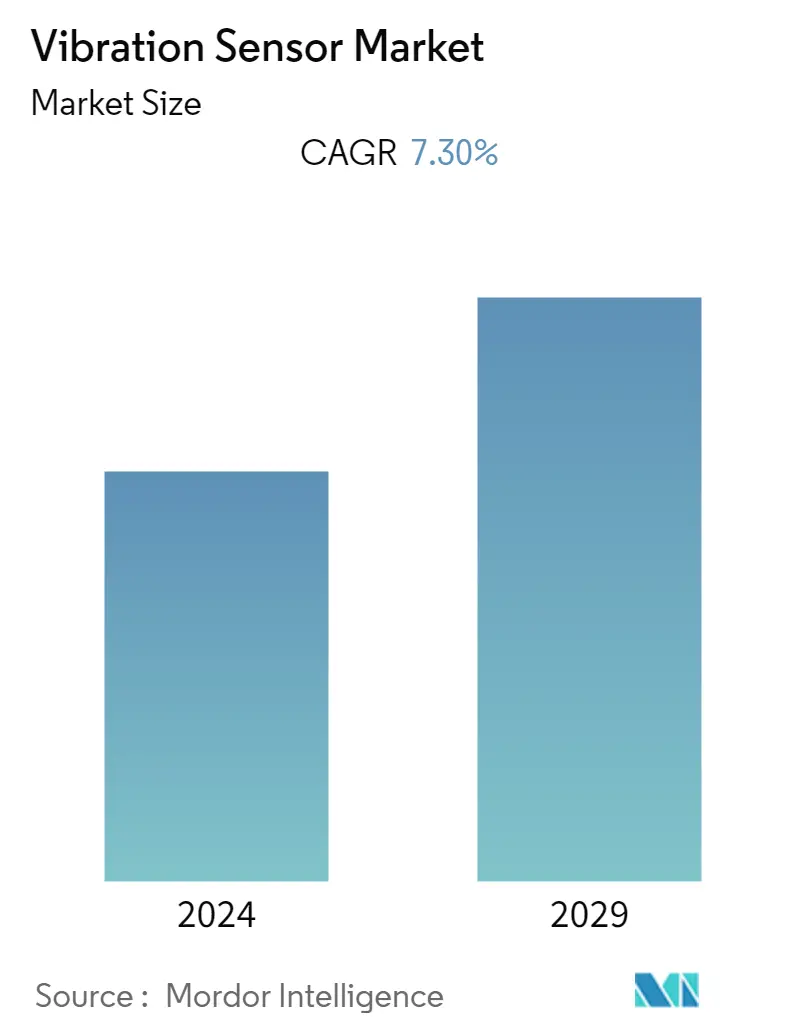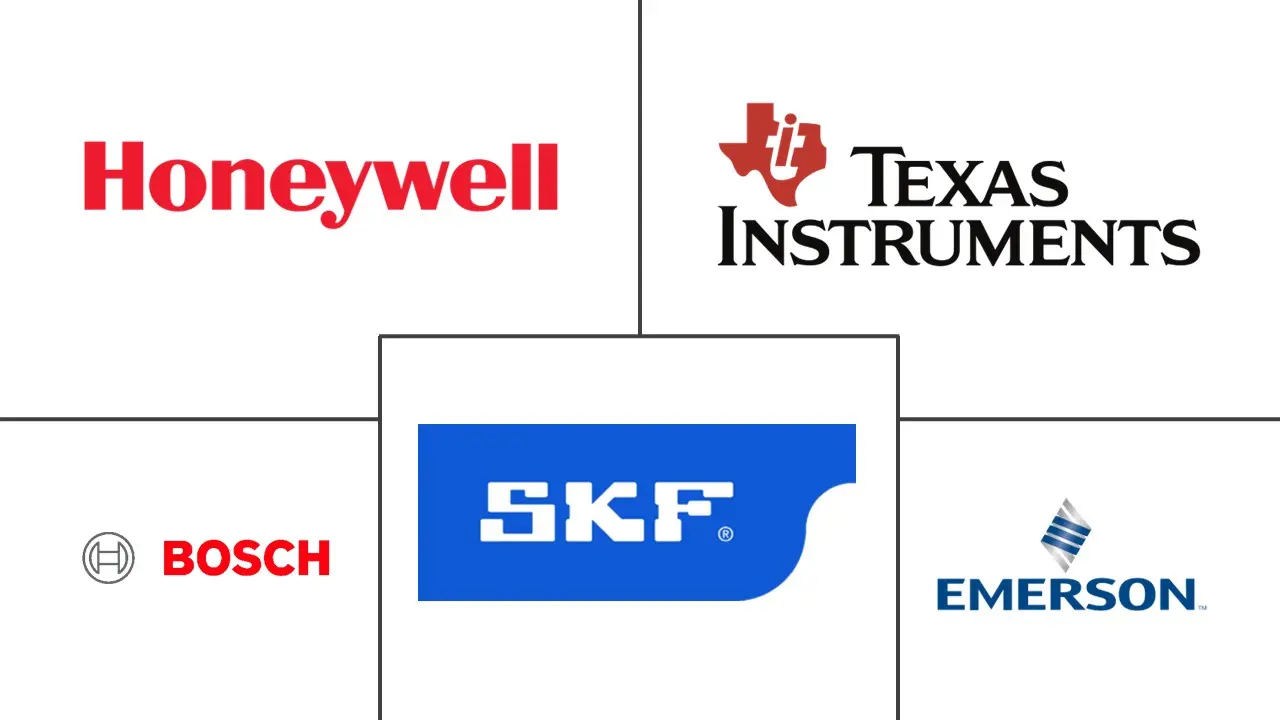Market Size of Vibration Sensor Industry

| Study Period | 2019 - 2029 |
| Base Year For Estimation | 2023 |
| CAGR | 7.30 % |
| Fastest Growing Market | Asia Pacific |
| Largest Market | North America |
| Market Concentration | Low |
Major Players
*Disclaimer: Major Players sorted in no particular order |
Vibration Sensor Market Analysis
The vibration Sensor Market is expected to register a CAGR of 7.3% during the forecast period. Monitoring and analyzing vibrations of machines or other critical equipment in various industrial sectors have become a very crucial part of the predictive maintenance program. Typical applications demand vibration measurements in the horizontal, vertical, and axial directions on both the inboard and outboard motor bearings.
- In an increasingly competitive industrial market, where new features are required to produce ''smarter'' tools, monitoring the condition of various components has become a fundamental need. This is expected to boost the demand for vibration sensors over the forecast period.
- With the advent of industry 4.0, organizations have started being more bent on automation and predictive maintenance that allows them to prematurely detect the wear and tear in the machines and equipment. This is expected to boost the adoption of such sensors over the forecast period.
- In March 2022, Flusso announced the world's smallest air velocity sensor. The FLS122 has a footprint of only 3.5 by 3.5 mm, making it 80% smaller than today's smallest competitive device. Flusso's FLS122 sensor was designed specifically for board-mounted air velocity measurements for thermal management and filter monitoring in some of the most space-constrained and challenging environments.
- In addition, the demand for vibration sensors has been rising for the last few years, and compatibility concerns, especially with old equipment, have been identified as major challenges affecting the market.
- Furthermore, in March 2022, Spectris plc, a supplier of high-tech precision instruments, announced the acquisition of Dytran Instruments, a leading designer and manufacturer of piezo-electric and MEMS-based accelerometers and sensors. The USD 82 million deal will enable both companies to leverage complementary capabilities to improve customer offerings and accelerate product development.
- The increasing adoption of smart devices, such as smartphones, wearables, smart appliances, and implantable or ingestible medical devices, among others that use accelerometers, is expected to drive the growth of the vibration sensors market over the forecast period.
- For instance, in March 2022, Samsung launched the new Galaxy A-series Smartphone. An octa-core processor powers Samsung Galaxy A53 5G. It has a 120 Hz refresh rate and 6.50-inch touchscreen display, offering a resolution of 10802400 pixels at a pixel density of 407 pixels per inch. In Addition, Connectivity options on the Samsung Galaxy A53 5G include Wi-Fi 802.11 a/b/g/n/ac, GPS, Bluetooth v5.10, NFC, USB Type-C, 3G, 4G, and 5G. Sensors on the phone include an accelerometer, ambient light sensor, compass/ magnetometer, gyroscope, proximity sensor, and in-display fingerprint sensor.
- Vibration gyroscope sensors are also widely adopted for electronic stability control systems of vehicles, car navigation systems, motion-sensing for mobile games, camera-shake detection systems in digital cameras, robotic systems, radio-controlled helicopters, etc. In the last few years, smartphones have witnessed MEMS gyroscopes' great success, owing to their low-cost, miniature size, and lightweight.
- Furthermore, owing to the COVID-19 outbreak, the global supply chain and demand for multiple products have experienced disruption. Moreover, due to the production shutdown in China, numerous industries have observed a supply shortage of various products. However, market vendors are trying to provide services to enterprises, which is helping them get revenues.
Vibration Sensor Industry Segmentation
A vibration sensor is a device that detects and measures the amount and frequency of vibration in a system, machine, or piece of equipment. These measurements can detect asset imbalances or other problems and predict future breakdowns. Vibration monitoring and analysis are essential quality measurement phenomena in modern industrial infrastructure.
The studied market is segmented by Product Types such as Accelerometers, Velocity Sensors, and Non-contact Displacement Transducers among various Ends User Industries such as Automotive, Healthcare, Aerospace, Defense, Consumer Electronics, Oil and Gas, and multiple geographies. The impact of Covid-19 on the market is also covered under the scope of the study.
| By Product | |
| Accelerometers | |
| Velocity Sensors | |
| Non-contact Displacement Transducers | |
| Other Products |
| End User Industry | |
| Automotive | |
| Healthcare | |
| Aerospace and Defence | |
| Consumer Electronics | |
| Oil and Gas | |
| Other End User Industries |
| By Geography | ||||||
| ||||||
| ||||||
| ||||||
| ||||||
|
Vibration Sensor Market Size Summary
The vibration sensor market is poised for significant growth, driven by the increasing need for predictive maintenance across various industrial sectors. As industries strive to enhance operational efficiency and reduce downtime, the demand for vibration sensors is expected to rise. These sensors play a crucial role in monitoring and analyzing vibrations in machines, which is essential for maintaining the health of critical equipment. The integration of advanced technologies such as Artificial Intelligence and the Internet of Things is further propelling the market, as these innovations enable smarter and more efficient monitoring solutions. The shift towards automation and Industry 4.0 is also a key factor, as organizations seek to leverage predictive maintenance to preemptively address wear and tear in machinery.
The market landscape is characterized by a fragmented structure, with numerous global manufacturers competing for market share. Established brands like Texas Instruments, Honeywell, and Emerson hold a significant advantage due to their strong brand identities, which influence buyer behavior. Recent developments, such as the acquisition of Dytran Instruments by Spectris plc and the launch of innovative products by companies like TE Connectivity and STMicroelectronics, highlight the dynamic nature of the market. These advancements are not only enhancing product offerings but also expanding the application scope of vibration sensors in sectors like aerospace, consumer electronics, and automotive. The growing adoption of smart devices and the increasing demand for automation in manufacturing are expected to further drive market growth in the coming years.
Vibration Sensor Market Size - Table of Contents
-
1. MARKET INSIGHTS
-
1.1 Market Overview
-
1.2 Industry Attractiveness - Porters Five Forces Analysis
-
1.2.1 Bargaining Power of Suppliers
-
1.2.2 Bargaining Power of Buyers
-
1.2.3 Threat of New Entrants
-
1.2.4 Threat of Substitutes
-
1.2.5 Intensity of Competitive Rivalry
-
-
1.3 Industry Value Chain Analysis
-
1.4 Assessment of Impact of COVID-19 on the Industry
-
-
2. MARKET SEGMENTATION
-
2.1 By Product
-
2.1.1 Accelerometers
-
2.1.2 Velocity Sensors
-
2.1.3 Non-contact Displacement Transducers
-
2.1.4 Other Products
-
-
2.2 End User Industry
-
2.2.1 Automotive
-
2.2.2 Healthcare
-
2.2.3 Aerospace and Defence
-
2.2.4 Consumer Electronics
-
2.2.5 Oil and Gas
-
2.2.6 Other End User Industries
-
-
2.3 By Geography
-
2.3.1 North America
-
2.3.1.1 United States
-
2.3.1.2 Canada
-
-
2.3.2 Europe
-
2.3.2.1 Germany
-
2.3.2.2 United Kingdom
-
2.3.2.3 France
-
2.3.2.4 Rest of Europe
-
-
2.3.3 Asia Pacific
-
2.3.3.1 China
-
2.3.3.2 India
-
2.3.3.3 Japan
-
2.3.3.4 Rest of the Asia Pacific
-
-
2.3.4 Latin America
-
2.3.4.1 Brazil
-
2.3.4.2 Argentina
-
2.3.4.3 Mexico
-
2.3.4.4 Rest of the Latin America
-
-
2.3.5 Middle East & Africa
-
2.3.5.1 United Arab Emirates
-
2.3.5.2 Saudi Arabia
-
2.3.5.3 South Africa
-
2.3.5.4 Rest of the Middle East & Africa
-
-
-
Vibration Sensor Market Size FAQs
What is the current Vibration Sensor Market size?
The Vibration Sensor Market is projected to register a CAGR of 7.30% during the forecast period (2024-2029)
Who are the key players in Vibration Sensor Market?
SKF GmbH, Bosch Sensortec GmbH (Robert Bosch GmbH), Honeywell International Inc., Emerson Electric Corporation and Texas Instruments Incorporated are the major companies operating in the Vibration Sensor Market.

